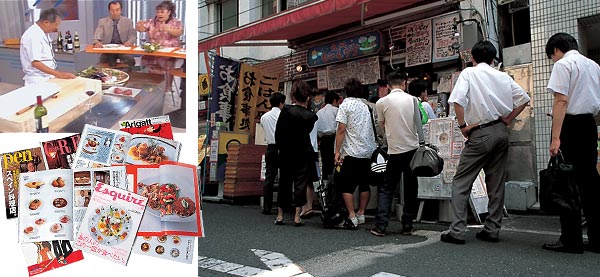|
|
|
NIPPONIA No.27 December 15, 2003
|
 |
 |
|
Born in the state of Oregon in the United States. After working as a journalist for The
Japan Times, Corliss became a freelance writer and translator in 2002.
|
 |
|
Top: A scene from Shokusai Roman, an NHK TV program. Guests are invited to taste food prepared by a chef, who is proud of his creations.
Above: Japan has many magazines featuring food. Right: If the media reports that a certain ramen restaurant serves excellent noodles, there is sure to be a line of people waiting to eat there. |
Food: Fondness, Fixation or Fad?
Photos by Sugawara Chiyoshi, Other photo collaboration: NHK
|
The Japanese can be fanatic about food. Food information is more important to the Japanese than information on politics, fashion or any other topic but the economy, according to a survey done by the Hakuhodo Institute of Life and Living.
Judging only from Japanese television, one could be forgiven for assuming that Japan is a nation of gourmets and gluttons. Basically, the Japanese like to eat food, and they like to watch it being eaten... and prepared... and discussed. Meanwhile, the restaurants featured on TV are swamped with hordes of customers. The eating part I understand, but the rest is lost on me.
Food-related television programs span the gamut — from shows on how to cook and how to eat, to programs on exotic foods, restaurants and eating contests.
Food programs started to become popular during the mid 1980s, as more people had more money to spend on their stomachs. Food program airtime has jumped by a factor of seven in roughly the last decade, and the shows continue to boast high viewer ratings, explains Nanbu Tetsuhiro, a researcher at the Hakuhodo Institute for Life and Living.
Tsuchiya Masayuki, a producer of food programming at NHK, attributes the popularity of food programming to its universality. "Food has to do with life, so food shows benefit everyone. And everyone, regardless of age or gender, likes to eat delicious food — so everyone is interested, "opines Tsuchiya.
"TV shows about food are inexpensive for broadcasters to produce," points out Philip Brasor, a media journalist.
Likewise, the publishing industry and the Internet have also experienced a glut of food content. A wide array of food magazines, featuring everything from recipes to restaurant reviews — even one dedicated to ramen — line magazine racks. "One reason for food's ubiquity in the media is the more cultural/aesthetic stance of the Japanese regarding food," adds Brasor.
"I think that the Japanese put a lot of emphasis on enjoying the appearance of food," Tsuchiya said. Japanese strive to present food in a way that is pleasing to the eye, not just the palate, such as by using glass dishes when the weather is hot, to make the meal appear cooler, he added.
"People like to watch shows about food and eating, for the same reason they like to watch shows about traveling or drama," a friend told me. "People want to eat what they can't eat and go places where they can't go." It would seem that the proverbial "grass is greener on the other side" syndrome is at work here in the culinary dimension — something along the lines of "the food next door is tastier."
Ultimately, I cannot empathize with the Japanese hunger for vicariously enjoying information on food. This all begs the question: do you eat to live, or live to eat? I would fall into the former category — but that is not to say I would turn down a good meal.
|
|
||||||||
|
||||||||
|